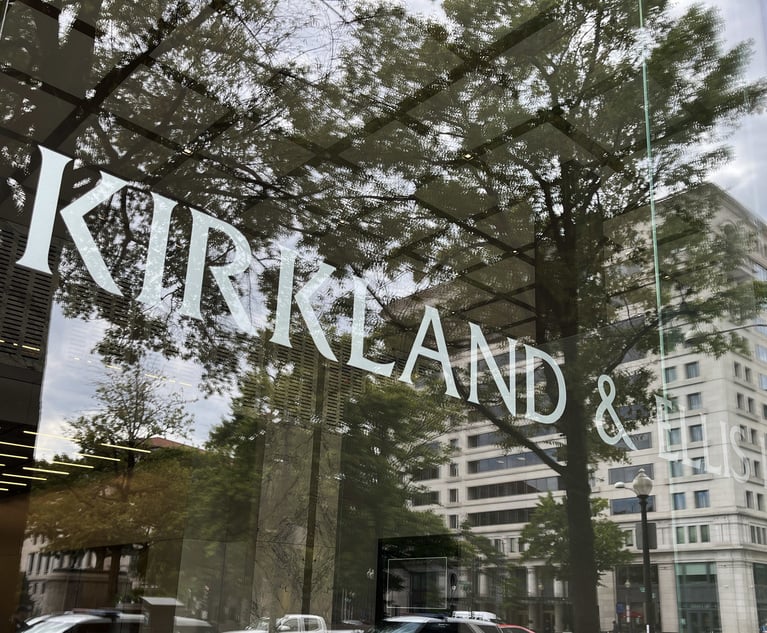More Evidence Rolls In: Law Firms Boosted Revenues, Profits in 2018
The second half of the Am Law 100 performed nearly as well as the top 50, according to Wells Fargo. Growth for the Second Hundred, while positive, still lagged significantly.
February 01, 2019 at 01:24 PM
4 minute read
 Photo: Shutterstock.com
Photo: Shutterstock.com
Law firm lenders at Wells Fargo and Citigroup, Inc. have been predicting for months that 2018 would turn out to be a post-recession high mark for the industry. On Thursday Wells Fargo finally revealed some full-year numbers, and they didn't disappoint.
The Wells Fargo “year-end check-in,” featuring survey data from 150 law firms primarily in the Am Law 200, reported average revenue growth of 5.9 percent and average net income growth of 7.6 percent, the strongest numbers since before the Great Recession.
“The big differentiator was that in 2018, for the first time in a really long time, what drove revenue was more than just rate increases,” said Joseph Mendola, senior director of sales with the Wells Fargo Private Bank Legal Specialty Group. “It was the combination of rate increases and increases in demand.”
Wells Fargo saw demand across all firms, measured by total billable hours logged, rise 2.3 percent over the previous year, ahead of the 1.3 percent growth of 2017. Meanwhile, rates increased steadily in the 4 to 6 percent range.
Break down the numbers between the Am Law 100 and the Second Hundred, however, and the firms in the latter grouping continue to have grounds for concern. While demand grew among the Am Law 100 by 3.9 percent, compared to 2.1 percent in 2017, for the Second Hundred, growth was just 0.1 percent. Still, this figure was a jump from the 0.8 percent decline from the previous year.
Contrary to other recent findings suggesting that the Am Law 50 were pulling away from the rest of the pack, the Wells Fargo survey revealed that growth in the Am Law 50-100 was almost as strong. While the strongest revenue gains were in the top 50, at 7.7 percent, the figure for the second 50 was not far behind, at 6.5 percent. Meanwhile, the second 50 actually grew net income at a higher rate: 8.2 percent compared to 8 percent for the top 50.
Mendola credited the robust performance of the second 50 to growth in litigation and other counter-cyclical practices, noting that the Am Law 50 has a bigger concentration of firms that are more heavily weighted towards transactional work.
“The deal business was still alive and well in 2018, but I think [demand] was more balanced in 2018 than 2017,” he said.
Still, stratification between the elite firms and the rest of the market remains a reality, Mendola noted.
“There's certainly a segment of firms that are identified by clients as 'go-to' firms for certain matters. It's a segment that has become more price insensitive,” he said. “The brand in that type of firms attracts deal work at rates that are significant different from what you see as you go down market.”
In spite of some predictions of dark clouds forming over the wider economy, thanks to uncertainties over international trade and the consequences of the record-setting government shutdown, the survey indicates that 2019 will start well for law firms.
Just as in 2018, firms reported beginning this year with a strong inventory level, and in all market sectors, firms forecast revenue growth for the year: 5.9 percent in the Am Law 100 and 3.5 percent in the second hundred.
“They're not huge increases,” Mendola said. “But participants are feeling positive.”
Read More:
Best Year in a Decade for Law Firms? Maybe, But Not for Everyone
Wells Fargo Adds to the Consensus: The Law Firm Market Is Setting Records
Demand, Revenue Continued to Grow in Third Quarter, Citi Survey Says
Law Firm Leaders Express Growing Anxiety Over Global Economic Outlook
This content has been archived. It is available through our partners, LexisNexis® and Bloomberg Law.
To view this content, please continue to their sites.
Not a Lexis Subscriber?
Subscribe Now
Not a Bloomberg Law Subscriber?
Subscribe Now
NOT FOR REPRINT
© 2025 ALM Global, LLC, All Rights Reserved. Request academic re-use from www.copyright.com. All other uses, submit a request to [email protected]. For more information visit Asset & Logo Licensing.
You Might Like
View All
Paul Hastings, Recruiting From Davis Polk, Adds Capital Markets Attorney
3 minute read
Kirkland Is Entering a New Market. Will Its Rates Get a Warm Welcome?
5 minute read

Goodwin Procter Relocates to Renewable-Powered Office in San Francisco’s Financial District
Trending Stories
- 1Decision of the Day: Judge Dismisses Defamation Suit by New York Philharmonic Oboist Accused of Sexual Misconduct
- 2California Court Denies Apple's Motion to Strike Allegations in Gender Bias Class Action
- 3US DOJ Threatens to Prosecute Local Officials Who Don't Aid Immigration Enforcement
- 4Kirkland Is Entering a New Market. Will Its Rates Get a Warm Welcome?
- 5African Law Firm Investigated Over ‘AI-Generated’ Case References
Who Got The Work
J. Brugh Lower of Gibbons has entered an appearance for industrial equipment supplier Devco Corporation in a pending trademark infringement lawsuit. The suit, accusing the defendant of selling knock-off Graco products, was filed Dec. 18 in New Jersey District Court by Rivkin Radler on behalf of Graco Inc. and Graco Minnesota. The case, assigned to U.S. District Judge Zahid N. Quraishi, is 3:24-cv-11294, Graco Inc. et al v. Devco Corporation.
Who Got The Work
Rebecca Maller-Stein and Kent A. Yalowitz of Arnold & Porter Kaye Scholer have entered their appearances for Hanaco Venture Capital and its executives, Lior Prosor and David Frankel, in a pending securities lawsuit. The action, filed on Dec. 24 in New York Southern District Court by Zell, Aron & Co. on behalf of Goldeneye Advisors, accuses the defendants of negligently and fraudulently managing the plaintiff's $1 million investment. The case, assigned to U.S. District Judge Vernon S. Broderick, is 1:24-cv-09918, Goldeneye Advisors, LLC v. Hanaco Venture Capital, Ltd. et al.
Who Got The Work
Attorneys from A&O Shearman has stepped in as defense counsel for Toronto-Dominion Bank and other defendants in a pending securities class action. The suit, filed Dec. 11 in New York Southern District Court by Bleichmar Fonti & Auld, accuses the defendants of concealing the bank's 'pervasive' deficiencies in regards to its compliance with the Bank Secrecy Act and the quality of its anti-money laundering controls. The case, assigned to U.S. District Judge Arun Subramanian, is 1:24-cv-09445, Gonzalez v. The Toronto-Dominion Bank et al.
Who Got The Work
Crown Castle International, a Pennsylvania company providing shared communications infrastructure, has turned to Luke D. Wolf of Gordon Rees Scully Mansukhani to fend off a pending breach-of-contract lawsuit. The court action, filed Nov. 25 in Michigan Eastern District Court by Hooper Hathaway PC on behalf of The Town Residences LLC, accuses Crown Castle of failing to transfer approximately $30,000 in utility payments from T-Mobile in breach of a roof-top lease and assignment agreement. The case, assigned to U.S. District Judge Susan K. Declercq, is 2:24-cv-13131, The Town Residences LLC v. T-Mobile US, Inc. et al.
Who Got The Work
Wilfred P. Coronato and Daniel M. Schwartz of McCarter & English have stepped in as defense counsel to Electrolux Home Products Inc. in a pending product liability lawsuit. The court action, filed Nov. 26 in New York Eastern District Court by Poulos Lopiccolo PC and Nagel Rice LLP on behalf of David Stern, alleges that the defendant's refrigerators’ drawers and shelving repeatedly break and fall apart within months after purchase. The case, assigned to U.S. District Judge Joan M. Azrack, is 2:24-cv-08204, Stern v. Electrolux Home Products, Inc.
Featured Firms
Law Offices of Gary Martin Hays & Associates, P.C.
(470) 294-1674
Law Offices of Mark E. Salomone
(857) 444-6468
Smith & Hassler
(713) 739-1250









